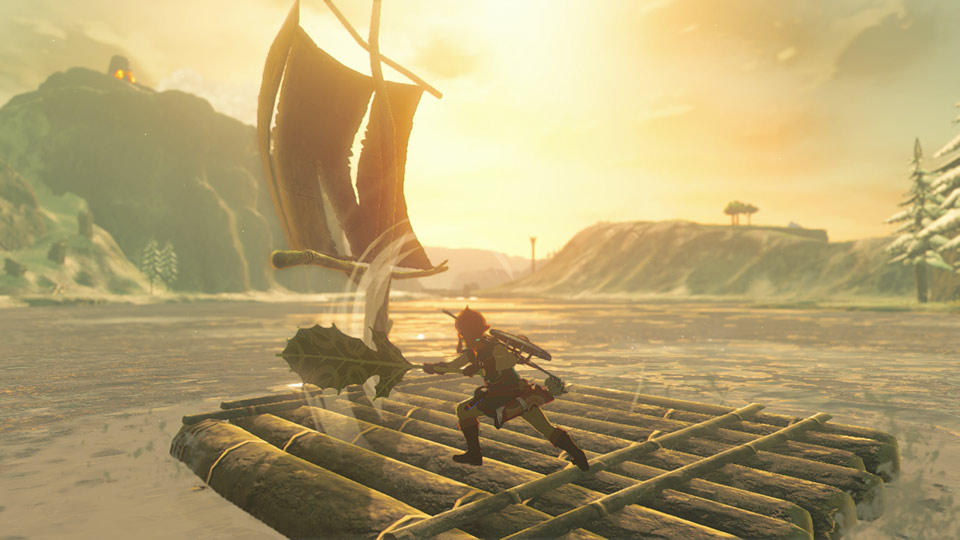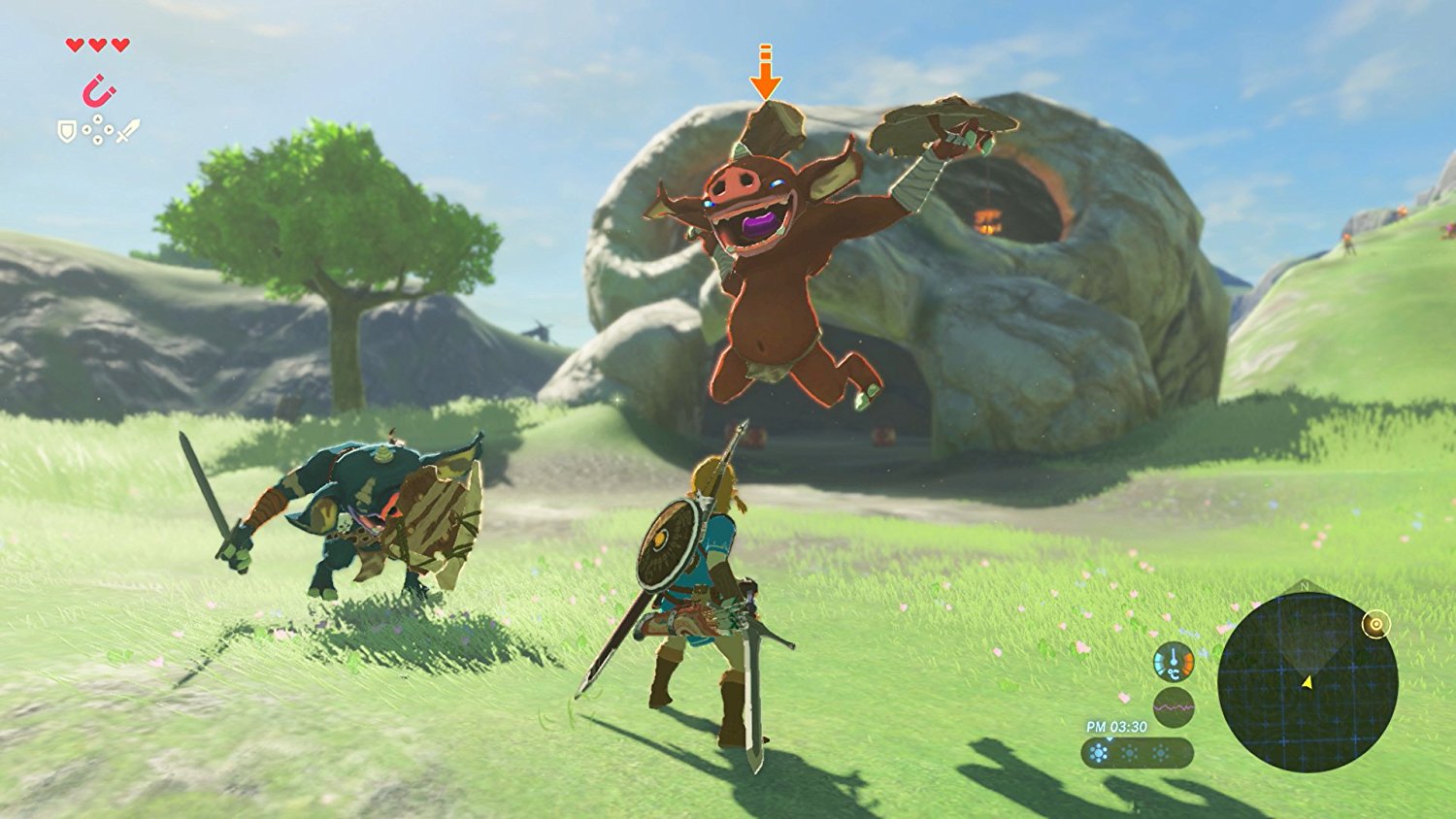Platforms:
, Nintendo Switch
Released:
March 3, 2017
Publisher:
Nintendo
Developer:
Nintendo Software Planning & Development
Describing The Legend of Zelda: Breath of the Wild in a way that properly impresses upon you the scope, the artistry, the wonderment and the beating heart that is presented from Nintendo is an incredibly difficult task. Arguably one of the most anticipated releases in gaming history, the weight on the shoulders to be able to merely achieve expectations is one thing, but to exceed those lofty expectations in almost every single way? Now that would be truly amazing. But Breath of the Wild does it, constantly reminding you that there are secrets at every turn, mysteries to uncover and a gigantic, glorious world like no other to explore. It could quite possibly be the best Zelda game ever created.

Link awakes from a hundred year sleep, memories lost and the kingdom of Hyrule destroyed by the force known as Ganon. Mechanical corpses litter the fields outside the castle walls, debris fills the landscape and locations that would normally be familiar and safe are in a dilapidated state. Despite this, the core of the tale remains that you must find Zelda, figure out what has happened and try to restore Hyrule to its former beautiful glory.
It’s made abundantly clear in Breath of the Wild that survival is key, not just in a combat sense. Once completing the more simple tutorial section in the Grand Plateau, the huge (and I really do mean huge) open world reveals itself, with long winding roads, massive forests and far reaching mountains filling the landscape. I’ve seen many open worlds before claim that you can go anywhere, but with Link’s ability to climb, I have yet to come across anywhere that I have been unable to visit; it truly does feel like everywhere I go is completely my choice.
“…Hyrule becomes a playground of hidden treasure chests, shrines, challenging enemies and special bonuses…”
More than that, the world is filled with things to do, including secrets and surprises that you won’t expect. To spoil them here would be to spoil part of the experience when you go out exploring on your own, but what I can tell you is that I was genuinely overwhelmed with just how much I was able to uncover without a specific goal in mind other than to “see what I can discover”. As you become comfortable with your abilities, Hyrule becomes a playground of hidden treasure chests, shrines, challenging enemies and special bonuses that make even the smallest play session feel very rewarding.
As someone who normally places a high value on having clear direction and mission structure, Breath of the Wild made a true believer out of me in terms of being able to craft my own adventure. Of course there is a main narrative to follow and these main quests are simple enough to follow if you are solely focuses on this, but to skip through the magical journey that leads to your ultimate goal would be to rob yourself of what makes this Zelda the most special. I lost count of the amount of hours I spent just picking a direction or a portion of the map and exploring it freely, which is a testament to how engaging the mysteries can be to uncover.
This is all tied together by the Sheikah Slate, a multi-purpose tool for Link that gives him additional abilities that are crucial to completing your quest. It works as a map that you can use to highlight points of interest and fast travel, but the opening of the game gets you completing shrines to be able to really unlock its true potential. Soon enough, you can use the ability to put objects into stasis, magnetise metallics, throw bombs and cause ice to protrude out of any body of water.

It’s here that the true genius of the game design shines through, as these abilities are repeatedly put to the test in different ways, not only in the over 100 shrines that are littered throughout the world, but in the devilishly tricky dungeons you’ll encounter. I have to talk about the shrines, because they’re my newest addiction. Found throughout the world, they act as big puzzle rooms and combat challenges, absolutely perfect for a short gaming burst and essential in making Link stronger with more hearts and stamina. To call them optional would be short-sighted; along with being important to progress, they share in some of my favourite Breath of the Wild moments so far.
Despite adventuring and uncovering magical mysteries being at its core, I can’t discount the other complex gameplay features in this wonderful package. Combat starts off simple enough with a bit of hack ‘n’ slash, but then evolves into a system that is to be taken very seriously. It’s not Dark Souls level of difficult or anything like that, especially with the super generous auto-save function, but if you let your guard down this game can and will kick your arse. Whenever I took my foot off of the accelerator and went in nonchalantly against a new enemy type, foes surprised me with their defensive capabilities and their quick responses to my missteps. Dodging and jumping out of the way is important, especially when weapons so easily break and disappear.
In fact, that’s my one criticism; weapons and shields shatter into pieces after only a few uses, forcing you to find quick replacements or replace them on the fly. While there is a warning that flashes up when a weapon is close to using up its durability, there were definitely times when I was in an intense battle and I lost what I was holding at a crucial moment. It’s not like there is a lack of weapons available in the world, as you’re constantly swapping out weaker ones for stronger ones as you open chests and take them from dead baddies, but when you do find a sword that is fantastic and strong, it’s almost a little heartbreaking when it shatters into lots of little pieces in front of you.
Luckily, there is no such limit on the amount of ingredients that you can hold, which is just perfect as almost everything you see in Breath of the Wild can be mixed with other ingredients and cooked into something that will give you health, stamina, stat boosts and more. Mushrooms, bugs, fish, flowers and even monster guts are just some of the examples that can be mixed together to make a handy elixir or a plate of food that could turn the tides of battle in an instant. Cooking itself isn’t explained clearly, which makes combining different ingredients based on suggestions alone into a mini-game in and of itself.
“Everything feels organic, from the bosses you encounter, the shrines you stumble across and the world at your oyster.”
That’s the beauty of the entire experience; nothing is handed to you on a silver platter. Everything feels organic, from the bosses you encounter, the shrines you stumble across and the world at your oyster. Towers unlock a region on the map, but it doesn’t show you specific objectives or points of interest. It merely gives you a rough outline of the land, and the rest is up to you. Being on top of these towers gives you the opportunity to visually take in your surroundings and tag things that are striking to you, which you can then glide on down to from the high vantage point.
You’ll want to take in the visuals, too, with outstanding weather effects and an art direction that completely takes advantage of the Switch and what it’s capable of. Colours pop off the screen, the environments are varied cleverly indicating your region and temperature, and lighting effects stand out as truly gorgeous. Characters are very expressive both in their visual style and their dialogue, which is good considering most of the words are written and not spoken. I found myself constantly wanting to talk to everybody I came across, even though there wasn’t necessarily a side-quest attached to them. It’s worth noting that the game also looks fantastic when in handheld mode; frame rate is more consistent and the style really excels on the smaller screen.
Positive:
- Gigantic world
- Full of secrets
- Deep combat
- Adventure at your pace
- Shrines are the actual best
Negative:
- Weapons break easily
I can’t think of a more detailed adventure experience than The Legend of Zelda: Breath of the Wild. Many games try to do too many things and end up a master of none, but incredibly, this feels like a master of all of them. Nintendo have managed to inspire in me a feeling that I haven’t experienced since playing Ocarina of Time as a child. A feeling of fantasy, mystery, uncovering memorable moments that are mine to keep and trading tales with my friends. It is the true essence of what makes video games so special, captured here in a game that I have played for many hours and will continue to play for a hundred more. The Legend of Zelda: Breath of the Wild is, simply put, a masterpiece.

















